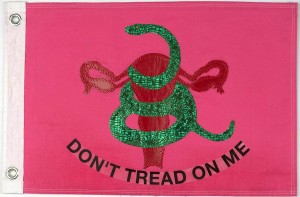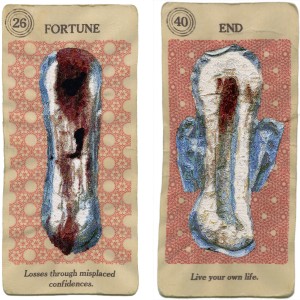
The Official Flag of The Exquisite Uterus Project; Artist Jeni Mokren; On loan from the collection of Helen Klebesadel
The Exquisite Uterus: The Art of Resistance
It is a fabulous collection of fiber based artworks that have been created to give voice to shared outrage at ongoing attacks on access to good and affordable reproductive healthcare for all women. Started in early 2012 in reaction to the what is still being called the most current ‘War on Women,’ two artists, known notorious Feminists, and sometime curators Helen Klebesadel and Alison Gates decided to facilitate a collaborative art project to channel their shared outrage at the attacks on women’s ready access to quality general and reproductive health care of their choice.
Interested artists and other motivated participants are again asked to embellish a plain cloth uterus “blank” (a square of organic white cotton canvas fabric with a simple black and gray medical illustration of a female reproductive system printed permanently on its surface.) Final works should be approximately 13″ square. Participation is free except for the cost of purchasing the organic cotton canvas uterus and mailing.
Participants are invited to manipulate the blank uterus in any way their fertile imaginations desire, making their prodigious powers of self-expression and creativity obvious to all.
Alison and Helen only ask that you don’t take your uterus for granted. Claim it! Have fun with it but take your control of your own personal uterus very seriously.
“It is your X#%@# uterus! Do whatever you want with it.”
Jessica Larson
Combining interests in anthropology, abstraction, and Kiki Smith’s art involving the female body, artist Jessica Larson’s new series mines issues of taboos and attraction versus repulsion. Turning the traditional concept of embroidery work on its head, Woman Troubles begs the question, “Can something be so ugly that it’s beautiful?”
These stitches are working to say something that feels far from the traditional, polite embroidery of the past. Embroidery techniques have been used to “prettify” textiles, yet the less attractive topic of menstrual cycles conflicts with one’s automatic association with embroidery.
Larson’s imagery uses the common language of menstruation—so common that upon viewing, women respond to individual pads with the exclamation, “I’ve had that one”—to facilitate a public conversation about a private topic.
Although the individual pieces may be similar, there is a compulsion to see meaning into them. Akin to reading tarot cards, we may contemplate their messages to better understand the divinations of the female body. It is a funny, absurd exercise, imagining a world where the blood tells your fortune.
Gwenn Seemel
I always assumed that I would have children one day. It wasn’t something that I felt strongly about, but I did think I would doit. Then, a few years ago, I was diagnosed with endometriosis, a disease that often causes infertility. Suddenly the future I hadn’t cared much about seemed important. The maybe-never of it put me in a should-I-even-try frame of mind.
I’d been told that the urge to reproduce is primordial, so I turned to nature to look for the origins of our baby-making obsession. To begin with, all I found was the animal version of “first comes love, then comes marriage, then comes the baby in the baby carriage.” But eventually I began to understand that the scientists who described animal behavior could be as stuck in a nursery rhyme version of normalcy as me, and I began to find scientists who weren’t.
As I research, I broadened my question. I could see that this was really about all the things that we think women and men have to do in order to be natural.
For all my investigating, I still couldn’t control whether or not I can have children, but I could decide to have a children’s book, and so I did. Crime Against Nature is that book and it includes these paintings among others. It’s meant for the kid in all of us: the person who hasn’t yet felt the pressure to conform, the one who still sees the infinite possibilities of being.
For more information, visit www.wideningthecycle.com. For questions, please email the curator and exhibit planner, Jen Lewis, at info [at] wideningthecycle [dot] com.



